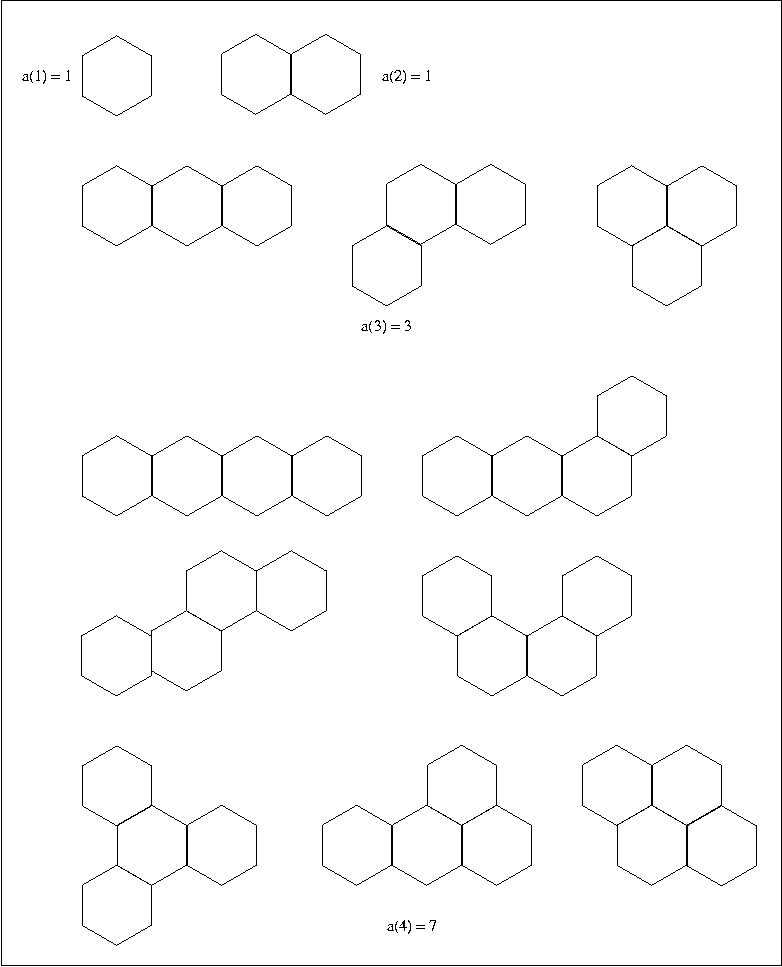Demonstration of the
On-Line Encyclopedia of Integer Sequences® (OEIS®)
(Page 5)

Identifying a Sequence: a Sequence From a Chemical Journal
A chemist reading a technical journal comes
across the sequence
1, 3, 7, 22, 82, 333, 1448, ...
and wonders if there is a simple mathematical formula for it.
He or she goes to the main web page of the
OEIS
and enters the sequence,
as in the previous demonstrations.
This produces the following response.

|
| |
|
|
A000228
|
|
Number of hexagonal polyominoes (or planar polyhexes) with n cells.
(Formerly M2682 N1072)
|
|
36
| |
|
|
1, 1, 3, 7, 22, 82, 333, 1448, 6572, 30490, 143552, 683101, 3274826, 15796897, 76581875, 372868101, 1822236628, 8934910362, 43939164263, 216651036012, 1070793308942
(list; graph; refs; listen; history; edit; internal format)
|
|
|
|
OFFSET
| 1,3
|
|
|
COMMENTS
| Comments from Markus Voege (Nov 24 2009) on the difference between this sequence and A038147: (Start)
The first term that differs is for n=6 and for all following terms the number of polyhexes is larger then the number of planar polyhexes.
If I recall correctly polyhexes are clusters of regular hexagons that are joined at the edges and are LOCALLY embeddable in the hexagonal lattice.
``Planar polyhexes'' are polyhexes that are GLOBALLY embeddable in the honeycomb lattice.
Example: (Planar) polyhex with 6 cells (x) and a hole (O):
.. x x
. x O x
.. x x
Polyhex with 6 cells that is cut open (I):
.. xIx
. x O x
.. x x
This polyhex is not globally embeddable in the honeycomb lattice, since adjacent cells of the lattice must be joined. But it can be embedded locally everywhere. It is a start of a spiral. For n>6 the spiral can be continued so that the cells overlap.
Illegal configuration with cut (I):
.. xIx
. x x x
.. x x
This configuration is NOT a polyhex since it the vertex at
.. xIx
... x
is not embeddable in the honeycomb lattice.
One has too keep in mind that these definitions are inspired by chemistry. Hence potential molecules are often the motivation for these definitions. Think of benzene rings that are fused at an C-C bond.
The (planar) polyhexes are ``free'' configurations in contrast to ``fixed'' configurations as in A001207 = Number of fixed hexagonal polyominoes with n cells.
A000228 (planar polyhexes) and A001207 (fixed polyominoes) differ only by the attribute free-fixed, that is whether the different orientations and reflections of an embedding in the lattice are counted.
This configuration
. x x .... x
.. x .... x x
is counted once as free and twice as fixed configurations.
Since most configurations have no symmetry, (A001207 / A000228) -> 12 for n -> oo. (End)
|
|
|
REFERENCES
| A. T. Balaban and F. Harary, Chemical graphs V: enumeration and proposed nomenclature of benzenoid cata-condensed polycyclic aromatic hydrocarbons, Tetrahedron 24 (1968), 2505-2516.
A. T. Balaban and Paul von R. Schleyer, "Graph theoretical enumeration of polymantanes", Tetrahedron, (1978), vol. 34, 3599-3609
M. Gardner, Polyhexes and Polyaboloes. Ch. 11 in Mathematical Magic Show. New York: Vintage, pp. 146-159, 1978.
M. Gardner, Tiling with Polyominoes, Polyiamonds and Polyhexes. Chap. 14 in Time Travel and Other Mathematical Bewilderments. New York: W. H. Freeman, pp. 175-187, 1988.
F. Harary and R. C. Read, The enumeration of tree-like polyhexes, Proc. Edinb. Math. Soc. (2) 17 (1970), 1-13.
D. A. Klarner, Cell growth problems, Canad. J. Math., 19 (1967), 851-863.
J. V. Knop et al., On the total number of polyhexes, Match, No. 16 (1984), 119-134.
W. F. Lunnon, Counting hexagonal and triangular polyominoes, pp. 87-100 of R. C. Read, editor, Graph Theory and Computing. Academic Press, NY, 1972.
N. Trinajstich, Z. Jerievi, J. V. Knop, W. R. Muller and K. Szymanski, COMPUTER GENERATION OF ISOMERIC STRUCTURES, Pure & Appl. Chem., Vol. 55, No. 2, pp. 379-39O, 1983.
Jaime Rangel-Mondragon, Polyominoes and Related Families, The Mathematica Journal, 9:3 (2005), 609-640.
N. J. A. Sloane, A Handbook of Integer Sequences, Academic Press, 1973 (includes this sequence).
N. J. A. Sloane and Simon Plouffe, The Encyclopedia of Integer Sequences, Academic Press, 1995 (includes this sequence).
|
|
|
LINKS
| A. Clarke, Polyhexes
D. Gouyou-Beauchamps and P. Leroux, Enumeration of symmetry classes of convex polyominoes on the honeycomb lattice.
M. Keller, Counting polyforms
Joseph Myers, Polyomino, polyhex and polyiamond tiling
Ed Pegg, Jr., Illustrations of polyforms
N. J. A. Sloane, Illustration of initial terms
Eric Weisstein's World of Mathematics, Link to a section of The World of Mathematics.
|
|
|
CROSSREFS
| Equals (A006535 + A030225)/2.
Cf. A036359, A002216, A005963, A000228, A001998, A018190.
Cf. A001207, A057973.
Sequence in context: A111772 A018190 A187982 * A108070 A038147 A082271
Adjacent sequences: A000225 A000226 A000227 * A000229 A000230 A000231
|
|
|
KEYWORD
| nonn,nice,hard
|
|
|
AUTHOR
| N. J. A. Sloane (njas(AT)research.att.com).
|
|
|
EXTENSIONS
| a(13) from Achim Flammenkamp (achim(AT)uni-bielefeld.de) Feb 15 1999. a(14) from Brendan Owen, Dec 31, 2001
a(15) from Joseph Myers (jsm(AT)polyomino.org.uk), May 05 2002
a(16)-a(20) from Joseph Myers (jsm(AT)polyomino.org.uk), Sep 21 2002
a(21) from Herman Jamke (hermanjamke(AT)fastmail.fm), May 05 2007
|
| |
|

Note the keyword "hard"!
This indicates that all the terms known to science
are shown - no one knows the next term.
No formula, recurrence or simple algorithm is known for this sequence.

Clicking on the link in the line
Links: N. J. A. Sloane, Illustration of initial terms.
produces the following pictures:

This explains what the sequence is about, and suggests
why it is such a hard problem (because of the
requirement that the hexagons must lie in a plane).

Click the single right arrow to go to the next demonstration page,
or the single left arrow to return to the previous page.






|












